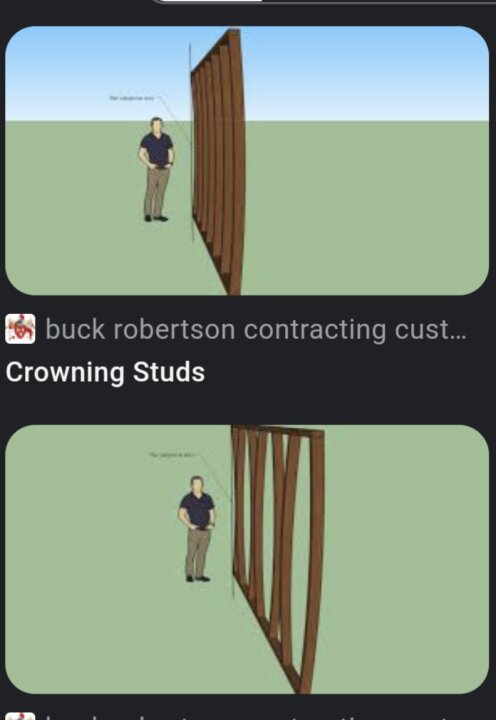This post may contain Mildly Adult content.
I'm not an installer ....but my dad was a builder and engineer, and a bit of a perfectionist .
And I listened to all his tips and tricks he gave out as he worked on our house as I grew up .
The idea about crowning has to do with the fact that wood warps, (or crowns), as it dries after being cut .
So the idea is , you try and face all the warping (or bowing ....or bending), the same way . ...which gives a smoother, flatter wall and less likelyhood of cracking at plaster joints, or gapping where it's nailed to the studs later on down the track .
It's not crucial ....you still get a wall, but it's just not as professional. Not as flat and can cause aesthetic problems later on like mentioned above.
This picture explains it pretty well .
If you get high quality wood that has been aged well or kiln dried ....it's likelyhood of warping any more is minimal .
But a lot of timber these days is sold still a little 'wet' or ' green' ...so yeah....crowning or 'facing their warp all the same becomes more important the greener the wood .
Hope this helps .
Edit ; we raplastered an old house ....and the studs were kinda all over the place .
We fixed this issue by using a insulative closed cell foam sheet layer over the studs before the plaster sheet went up .
This gave a sort of flexible 'buffer' and offered more thermal and sound insulation as well.
Plaster or drywall or whatever you call it, has a degree of flexibility so it can handle a little bit of warp here and there.
It's really only on large walls , that the sun is gonna shine or reflect on that you might see a visual issue if your studs aren't crowned all the same way .
But frankly ...mankind has lived with lath and plaster walls for years, and there's venetian plastering and all types of rendering .
Some plasteres use up to a 5 layer finish ....some just joint it.
So ....it's how picky you are I suppose, and hopefully how straight your timber is .
Although , if you have a particularly bad stud that sticks out, it might be worth planing it flatter.
And I listened to all his tips and tricks he gave out as he worked on our house as I grew up .
The idea about crowning has to do with the fact that wood warps, (or crowns), as it dries after being cut .
So the idea is , you try and face all the warping (or bowing ....or bending), the same way . ...which gives a smoother, flatter wall and less likelyhood of cracking at plaster joints, or gapping where it's nailed to the studs later on down the track .
It's not crucial ....you still get a wall, but it's just not as professional. Not as flat and can cause aesthetic problems later on like mentioned above.
This picture explains it pretty well .
If you get high quality wood that has been aged well or kiln dried ....it's likelyhood of warping any more is minimal .
But a lot of timber these days is sold still a little 'wet' or ' green' ...so yeah....crowning or 'facing their warp all the same becomes more important the greener the wood .
Hope this helps .
Edit ; we raplastered an old house ....and the studs were kinda all over the place .
We fixed this issue by using a insulative closed cell foam sheet layer over the studs before the plaster sheet went up .
This gave a sort of flexible 'buffer' and offered more thermal and sound insulation as well.
Plaster or drywall or whatever you call it, has a degree of flexibility so it can handle a little bit of warp here and there.
It's really only on large walls , that the sun is gonna shine or reflect on that you might see a visual issue if your studs aren't crowned all the same way .
But frankly ...mankind has lived with lath and plaster walls for years, and there's venetian plastering and all types of rendering .
Some plasteres use up to a 5 layer finish ....some just joint it.
So ....it's how picky you are I suppose, and hopefully how straight your timber is .
Although , if you have a particularly bad stud that sticks out, it might be worth planing it flatter.
GuyWithOpinions · 31-35, M
@OogieBoogie great answer thank you for answering my question.
OogieBoogie · F
@GuyWithOpinions I hope it gives you enought to make your own judgments on what you're working with .
Sometimes it matters, sometimes it doesn't .
I've seen studs that have twisted like 30⁰, a little like a piece of licorice, yet they are still a structural part of the framing and we just skipped nailing the plaster to them and moved onto the next one.
Plaster isn't so much structural as it's more just a finishing product. It's easy and convenient and quick to put up compared to older types of wall coverings.
If it's an old house ....nothing is going to be straight anyway 😂....not even a door frame .
If it's new, then you just do the best you can.
It is worth checking each stud first as there can be a few dud ones delivered : ones with twisty grain or cracks in them.
Good luck with your project .😊
Sometimes it matters, sometimes it doesn't .
I've seen studs that have twisted like 30⁰, a little like a piece of licorice, yet they are still a structural part of the framing and we just skipped nailing the plaster to them and moved onto the next one.
Plaster isn't so much structural as it's more just a finishing product. It's easy and convenient and quick to put up compared to older types of wall coverings.
If it's an old house ....nothing is going to be straight anyway 😂....not even a door frame .
If it's new, then you just do the best you can.
It is worth checking each stud first as there can be a few dud ones delivered : ones with twisty grain or cracks in them.
Good luck with your project .😊
GuyWithOpinions · 31-35, M
@OogieBoogie oh man that sucks. Usually if i have a twisted stud that i cant bend straight i put blocks in the cavity







